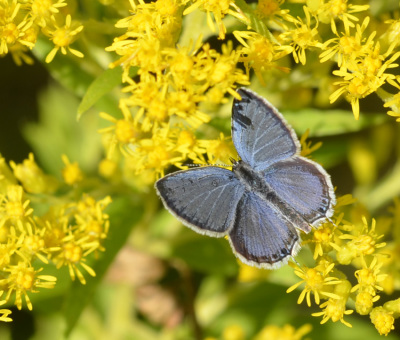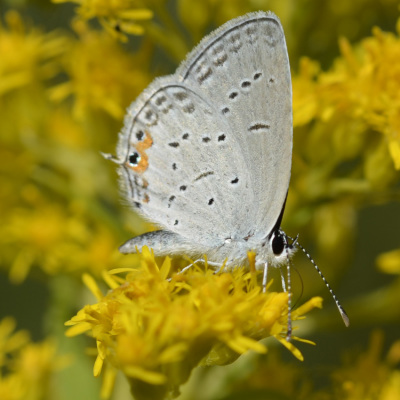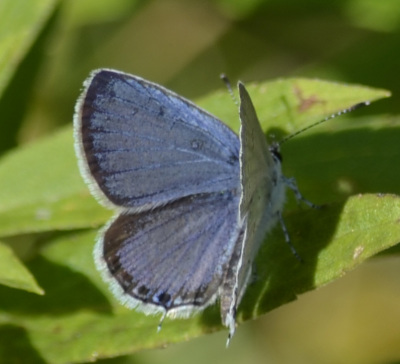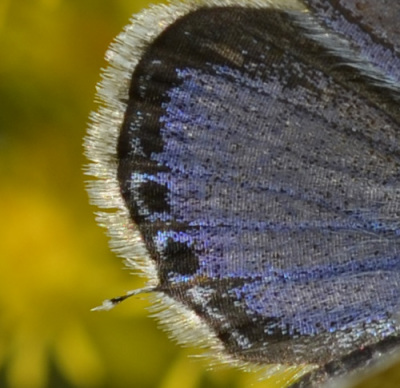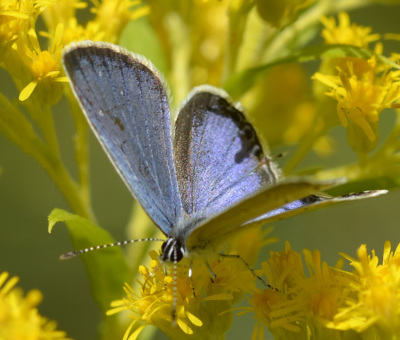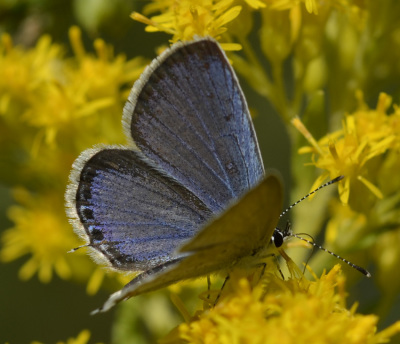I visited a Toronto park recently to take a peek at an accidental visitor, a juvenile Yellow Crowned Night Heron, but I was more captivated by a much smaller creature. A startlingly blue butterfly, nearly the same size as my thumbnail was posing artistically on the fresh goldenrod blossoms.
What Blue Butterflies Still Sun in September?
I had to wait till I was home to try to figure out what kind of butterfly it was. Some kinds of blue butterflies are only seen in the spring in southern Ontario. Others seem to abound in the early summer.
This one was seen on September 4 and yet it was very crisp and fresh. In fact, it had very tiny “tails” on its hind wings which further reading agreed are fragile and often break off as the butterfly ages.
That seemed to rule out one of the Spring Azures. There are also Summer Azures, though and technically September is still summer.
Photos of a Butterfly from Both Above and Below Help Aid Identification
I flipped through the photos in Kaufman’s Field Guide to Butterflies of North America.
The underside of my blue beauty was very helpful. As you can see, it had 2 little orange crescents above the black dots on its hind wings. That turned out to be a key feature.
The “tails” themselves on the hind wings gave another useful clue. According to the guide, the Eastern Tailed Blue is the only one sporting these tiny tufts in eastern Canada.
And this type of butterfly is sexually dimorphic. That just means the females and males don’t look alike. My amazingly blue butterfly was a male.
The Mystery of the Missing Orange Spots on the Wing Tops
The only concern I has was in the guide, the Eastern Tailed Blue is shown as having orange spots on top of the hind wings, as well as on the underside. To quote: “Both [male and female] have one or two orange spots near tail above.”
Mine did not have any obvious orange marks on the upper side.
Wandering around the internet, though, I found the Canadian Biodiversity Information Facility website of the Government of Canada has a slightly different interpretation. it says there are “two or three black spots, often orange-capped, near the tail.” “Often” to me doesn’t equal “always” so I found that reassuring.
Certainly the dozens of photos I looked at seemed to be otherwise identical to my butterfly.
And then I went through each of my photos again, squinting closely at the scales nearest the “tails.” I did find on one or two shots there was a small amount of orange visible.
So I feel comfortable concluding this should be a male Eastern Tailed Blue.
Do Eastern Tailed Blues Over-winter As Adults?
That brought me back to the freshness of this butterfly and the late-ish date. Some butterflies, like Mourning Cloaks, over-winter as adults. They lay their eggs in early spring. Others, like Monarchs, migrate south laying eggs the following spring.
Was this male of mine likely to over-winter or migrate?
Bugguide.net says that it’s unlikely. Usually these butterflies over-winter as mature larvae, “often inside a seedpod.”
So I hope this fellow helps create some caterpillars soon. They may need these last few precious weeks of summer and a summery-early autumn to mature.
What Do Eastern Tailed Blue Caterpillars Eat?
Fortunately, they are not picky eaters. In fact, among the many native and alien plants they like to munch on are White and Red Clovers and Cow Vetch. There’s no shortage of those in southern Ontario.
I hope that means I’ll find some of his descendants perched on the goldenrod next September!
Related Reading
Join In
Have you seen an Eastern Tailed Blue? Or one of the similar Summer or Spring Azures? Please share your experience with a comment.

